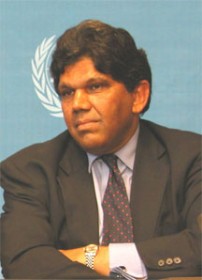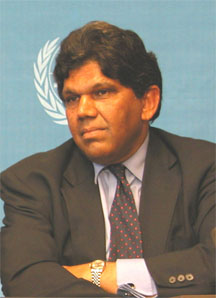By Dr Bertrand G. Ramcharan
The New York Times, on 8 May, 2010, carried a thoughtful article by Simon Romero on the road from Georgetown to Lethem. It discussed, among other things, Guyana’s development aspirations, its relations with Brazil, environmental issues, and the situation of Guyana’s indigenous peoples. Reading the article, one is impelled to ask what the policy implications are for the asphalting of such a road and how Guyana should go about addressing these implications. As far as one could ascertain, there has so far been no consolidated Government policy document or Parliamentary discussion of this issue. There should be. In this article we seek to offer an outline of policy implications that would need to be discussed seriously and swiftly in the country.

The first issue that arises for consideration is that of the principle of self-determination. The consequences of the further development of such a road should not be allowed to impact adversely on the national character or destiny of Guyana. Some years ago, the French Government proposed to settle in French Guyana some fifty thousand settlers from France. That would have altered the demographic character in the country and the local leaders, supported by Caribbean leaders, argued that the principle of self-determination required that the fundamental demographic structure of the country should not be so altered. This argument prevailed in the end. The same principle should apply in Guyana.
The second issue, closely related, is that of culture. Ours is a distinctive Guyanese culture within the broader Caribbean mosaic. We have a relatively small population. What would it do to the culture of our country to have a large influx of people with a distinctive and quite different culture? We need to think this through and, without any prejudgements, take a planned approach to this question.
The third issue is the environment. The New York Times article carried an estimate that should the road be paved, resulting traffic could have an adverse impact on more than two million acres of our pristine Iwokrama forests. It quoted Graham Watkins, a biologist and resource management consultant in Georgetown as saying: “Asphalted roads in tropical areas cause deforestation, poaching and attract settlement, and this road happens to run through one of the most species-rich areas in the world”.
The need for policy debate is striking. It might be possible to minimise the negative impact by prohibiting settlements or commercial activity in key areas. But that requires study and discussion in Guyana and a policy put forward and debated in the nation. It should not be left to political convenience.
The fourth issue is our indigenous population. As far as we are aware, they have not so far been given an opportunity to adequately express their views on the asphalting of the road and to make suggestions to prevent any adverse impact on them. This should be a priority. Respect for our original inhabitants demands such consultation.
The fifth issue is Guyana’s development. Chances are that the road could contribute in a significant way to Guyana’s future development. But we need to sit down and think through this, with the assistance of our experts, such as those of the Institute for Development Studies at the University of Guyana and its distinguished head, Professor Clive Thomas. What we need is a comprehensive policy carefully worked out through study, discussion, and debate in the country.
The sixth issue is our relations with Brazil. A road from Brazil to Georgetown would have great benefits for Brazil (a deep water port for exports from its northern farms) – and in all probability for Guyana as well. In a situation such as this, what other countries have done from early on is to establish a Joint Commission between the two countries that would discuss all aspects of the asphalting of the road, and the consequences, and make joint recommendations to both Governments that would be tabled and discussed in Guyana’s Parliament. In cases of need, Parliamentary approval should be sought. Responsible government should operate in this way. The Government should learn from some of the discussion about the way in which the Low-Carbon Development Strategy was launched.
The seventh issue is Guyana’s authority and administration in the Lethem area. From reports that one sees, there is already a major impact on this community from activities by settlers from Brazil. It should be a matter of urgent priority for Guyana to develop a strong Administration in the Lethem area. It would be appropriate for the Government or Parliament to designate a Regional Representative of Ministerial rank with authority and resources from Parliament. There is urgent need for a policy discussion of this issue.
The eighth issue is Guyana’s relations with CARICOM. Elementary courtesy requires that Guyana brief its CARICOM partners regularly on expected outcomes for Guyana of the further development of this road.
Doubtless, there are other policy implications of this road that would need attention. This article has sought to initiate a discussion on the subject. It would serve the nation well for those with insights and views on this topic to come forth and help in the development of carefully considered policies for the future of our nation.
There is a special responsibility on the opposition parties. On an issue as important as this all the political parties in Guyana should have position papers. And if the Government is lagging in the articulation of policies, shouldn’t the opposition use its leverage to bring about greater public awareness and discussion of these matters?
And again, we pose the question, where is the Parliament, and what are its responsibilities to the nation on matters such as these?

